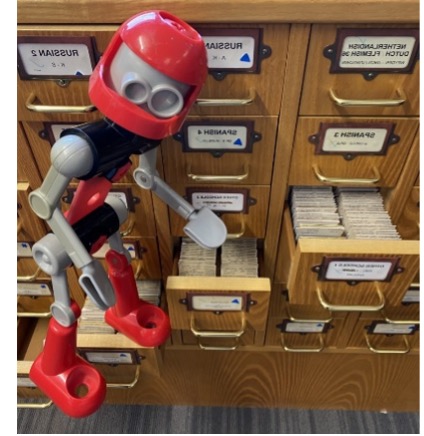
March 30, 2022, by amxap1
DTH Resources Spotlight: Slide Library by Virina Sheth
The Digital Transformation Hub houses a collection of 35mm slides which range from the early decades of twentieth century to the contemporary times. This collection of more than 80,000 slides can be found at A24, Humanities Building.
What are these Slides exactly?
The main body of the collection comprises fine art ranging from early Renaissance to contemporary and is divided into the national schools:
- American
- British
- French
- German
- Italian
- Netherlands
- Russian
- Spanish
There is also a large architecture collection. It includes photographs, plans and models of buildings from the Ancient world up to the late 20th century.
Other Slide Collections includes slides from other various fields such as: Sculpture, Photographers, Exhibitions. Classics, Film Stills, Posters and Advertisements, History and Historians and Print Media.
It’s an eclectic collection which includes images of sites, cities, maps, paintings, statuary, busts, reliefs, coins, mosaics and much more from- quite literally- all over the Ancient world.
They included famous depictions of the city by artists including J.M.W. Turner and Jan Siberechts, but many were also selected from the collection’s architecture section (bequeathed to the university by Alec Daykin in 2000)
How can these Slides be used?
Slides can be used in the DTH, where they may be viewed on lightboxes. We also have slide scanners in DTH and whilst there are copyright restrictions and ramifications, if scanned properly they make incredibly good digital images and faded, pink or blue slides can be brought back to vivid life using Photoshop which is available on several PCs in the centre.
Moreover, there are whole sections of the collection to which the University owns copyright, and which contain unique images which would be of great benefit digitised and made available for research. Slides may also be borrowed, and we have carousel slide projectors for loan by prior arrangement.
What our Professor Nicholas Alfrey has to say about the Slide Collection and why they can still be relevant:
(taken from https://blogs.nottingham.ac.uk/digitaldialogues/2017/04/11/notes-school-humanities-slide-collection-part-two-nicholas-alfrey/ )
This is not to claim that slides are a ‘better’ replica of the works of art they reproduced than a digital image. From a technical point of view, they were quite often inadequate, and they could also be subject to deterioration, so that even a high-quality image, if developed on unstable stock, could gradually turn a ghastly shade of pink. But a slide collection like this can tell us a great deal about how the history of art has been mediated. And we can really only appreciate how this works now that slides are no longer our main conduit to past artistic production.
It wasn’t only art historians who invested so much in slides: artists too have made use of them, and not just as a means of documenting their work. But artists have sometimes used slides directly as a means of creative expression, such as Robert Smithson in his Hotel Palenque (1969) or Nan Goldin’s The Ballad of Sexual Dependency (1985). In 2005, the Baltimore Museum of Art organized an exhibition devoted to the theme called SlideShow: Projected Images in Contemporary Art. The date of the exhibition is significant: it came a few months after Kodak announced that they would no longer be manufacturing 35mm slide projectors, and that slides had therefore become an obsolete visual technology. This very circumstance, however, has made a new generation of artists all the more keen to make use of them.
The main function of the slide collection was to support the teaching of art history, both on campus and in the programme of continuing education, though slides were also important for research presentations and public lectures. The collection reflects the interests, specialisms and enthusiasms of the academic staff of the department over the years, with lecturers adding to it according to their own developing concerns and projects. The history of the teaching of art history at Nottingham, at least up to the adoption of digital images, can be traced throughout the collection.
Many of the slides were produced by the University’s own photographic unit, in the days when it had one: they were photographed from reproductions in books, periodicals and catalogues, with images coming from obscure or hard-to-come-by sources as well as the obvious ones. The process could take several weeks: it was almost impossible to get a slide made in a hurry. The collection was also regularly enhanced through the slide subscription scheme run by the Courtauld Institute, in which selected works from temporary exhibitions or permanent collections would be photographed from the original: many of the highest-quality images entered the collection in this way. The St Martin’s School of Art also ran a scheme covering contemporary art exhibitions, to which the department subscribed once this area had become a regular aspect of the curriculum.
How the DTH volunteers are digitalising the slides:
The Archaeology slide and Hennessy collection digitisation projects are moving on apace. The former utilises DTH’s A4 scanners’ Transparency Units to capture the Archaeology department’s unique 35mm slides (some of which date back to the 1950s) at high resolutions. They are also transferring information about each image from the collection’s card index into a database so that both can be cr oss-referenced to build a searchable database and make these amazing images available to all.
Additional blog posts about specific slides can be found below:
https://blogs.nottingham.ac.uk/digitaldialogues/2017/02/10/inspiring-slides-picassos-le-gueridon-pedestal-table-jamie-shakespeare/ : This one talks about Pablo Picasso’s Le Guéridon (The Pedestal Table) – 1913/1914 and it’s history.
Another blog which is by Ariane Watson on Jan Siberechts’ Wollaton Hall and Park can be found here: https://blogs.nottingham.ac.uk/digitaldialogues/2018/05/03/inspiring-slides-jan-siberechts-wollaton-hall-park-ariane-watson/
No comments yet, fill out a comment to be the first



Leave a Reply